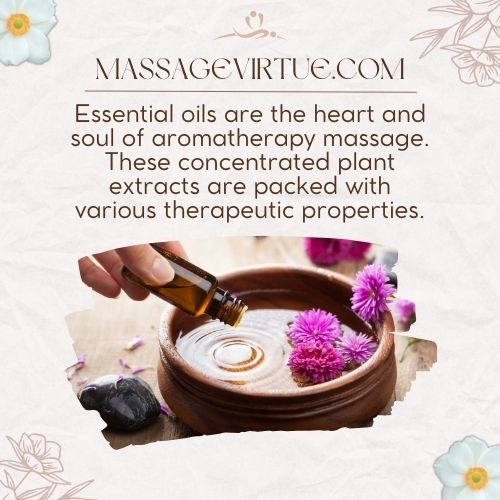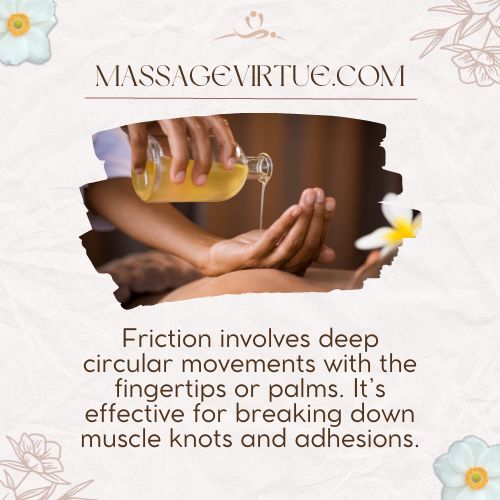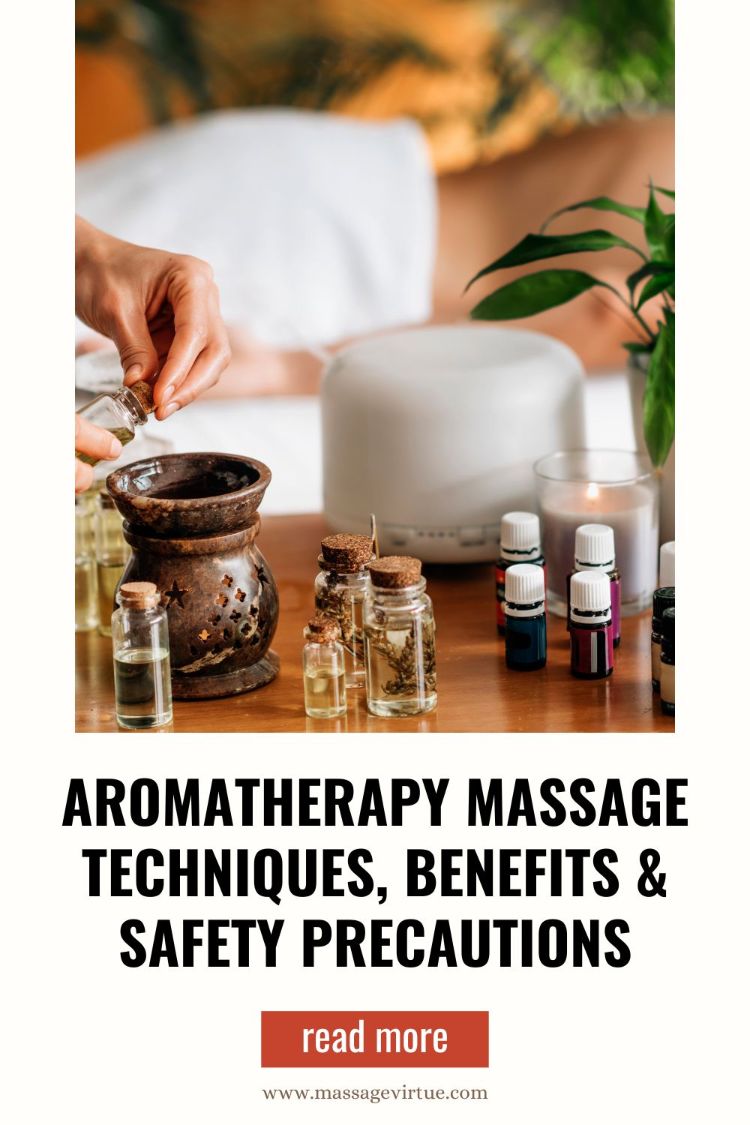Imagine a world where relaxation, stress relief, and pain relief are just a massage away. Well, you don’t have to imagine anymore because aromatherapy massage can make it a reality.
In this comprehensive guide, we’ll delve into the world of aromatherapy massage, uncovering the soothing power of essential massage oils, the magic of various massage techniques, and how this all ties into your overall health and wellness.
So, let’s get started on your journey to ultimate relaxation and rejuvenation with Aromatherapy Massage Techniques.
The Magic of Essential Oils
Essential oils are the heart and soul of aromatherapy massage. These concentrated plant extracts are packed with various therapeutic properties.
They come in various scents, each with its unique effect on the mind and body.

Some common essential oils used in aromatherapy massage include lavender, eucalyptus, chamomile, and peppermint.
Aromatherapy Massage Benefits
Aromatherapy offers numerous benefits, making it an excellent addition to your wellness routine. Let’s explore these benefits in more detail:
- Relaxation: Aromatherapy helps calm your mind and body, promoting deep relaxation.
- Stress Relief: The soothing scents of essential oils can significantly reduce stress levels.
- Pain Relief: Many essential oils possess analgesic properties, which can alleviate aches and pains.
- Improved Sleep: Aromatherapy can help you enjoy a peaceful night’s sleep.
- Enhanced Mood: Certain essential oils have mood-lifting effects, combating feelings of depression and anxiety.
Aromatherapy Massage Techniques
Now that we’ve set the stage, it’s time to dive into the various aromatherapy massage techniques. These techniques are easy to understand and can be performed by both professionals and beginners.
1. Effleurage
Effleurage is a gentle, gliding massage technique used to warm up the muscles and apply essential oils to the skin. It involves long, sweeping strokes that create a soothing sensation.
This technique is perfect for relaxation and enhancing the absorption of essential oils.
2. Petrissage
Petrissage is a kneading and squeezing technique that targets deeper muscle layers. It helps to alleviate muscle tension and improve circulation.
When combined with essential oils, it can offer significant pain relief benefits.
3. Tapotement
Tapotement is a rhythmic tapping or percussive technique. It stimulates muscles, increases blood flow, and can be invigorating.
This technique is ideal for stress relief and energizing massages.
4. Friction
Friction involves deep circular movements with the fingertips or palms.

It’s effective for breaking down muscle knots and adhesions. When combined with essential oils, friction can provide exceptional pain relief.
5. Aromatherapy Hot Stone Massage
Hot stone massage involves the use of heated stones in combination with essential oils. The stones are placed on specific points of the body, releasing tension and providing a deeply relaxing experience.
The heat from the stones enhances the absorption of essential oils and promotes overall relaxation.
6. Aromatherapy Scalp Massage
Aromatherapy isn’t just for the body; it’s for the mind too.
An aromatherapy scalp massage involves using essential oils on the scalp to relieve stress and promote hair health. It’s an excellent technique for relaxation and self-care.
7. Aromatherapy Foot Massage
Our feet work hard for us every day, and they deserve some pampering.
Aromatherapy foot massage combines essential oils with reflexology techniques to relax the entire body, reduce stress, and even improve sleep quality.
Safety Tips for Aromatherapy Massage
| Precautions | Description |
| Patch Test | Always perform a patch test with the essential oil to check for allergies or sensitivities. |
| Consult a Professional | If you have specific health concerns or are pregnant, consult a healthcare professional or aromatherapist before starting aromatherapy. |
| Quality Matters | Use high-quality, pure essential oils to ensure safety and effectiveness. |
| Dilution is Key | Essential oils should always be diluted before direct skin cont |
DIY Aromatherapy Massage
Aromatherapy massage doesn’t always require a professional. You can create a soothing experience in the comfort of your own home. Here’s how:
1. Choose Your Essential Oil: Start by selecting an essential oil that suits your mood and needs—lavender for relaxation, eucalyptus for congestion relief, or peppermint for an energy boost.
2. Dilute the Oil: Essential oils are potent and should be diluted with a carrier oil like coconut or almond oil. A common ratio is 2-3 drops of essential oil per teaspoon of carrier oil.
3. Set the Mood: Find a quiet, comfortable space and dim the lights. Play some soft, calming music to create a tranquil ambiance.
4. Warm the Oil: Gently warm your oil blend by rubbing it between your hands.
5. Begin Massaging: Use one of the techniques we discussed earlier – effleurage, petrissage, or tapotement – and start massaging the desired area.
6. Breathe Deeply: As you massage, take deep breaths to inhale the aromatic essence of the oil, enhancing the relaxation.
7. Enjoy the Benefits: Whether you’re seeking relaxation, stress relief, or pain relief, focus on the positive effects of your massage.
Conclusion
Aromatherapy massage techniques are a beautiful fusion of touch and scent, offering a path to relaxation, stress relief, and pain relief.
The power of essential oils in enhancing your well-being is truly remarkable.
Whether you seek professional massage therapy or choose to create your aromatherapy oasis at home, you’re on your way to a healthier, happier you.
FAQs
What Techniques Are Used in Aromatherapy Massage?
In aromatherapy massage, several techniques are used to relax and heal the body.
Some common techniques include effleurage (gentle strokes), petrissage (kneading and squeezing), tapotement (gentle tapping), and friction (deep circular movements).
What Does a Full-Body Aromatherapy Massage Include?
A full-body aromatherapy massage involves massaging the entire body, from head to toe, using essential oils.
The goal is to promote relaxation, reduce stress, and soothe muscle tension.
What Are the 4 Elements of Aromatherapy?
Aromatherapy is based on four main elements: essential oils, massage techniques, relaxation, and health benefits. These elements work together to provide a holistic approach to well-being.
What Are the Three Types of Aromatherapy?
There are three main types of aromatherapy: cosmetic aromatherapy (using essential oils for beauty and skincare), massage aromatherapy (combining oils with massage for relaxation), and olfactory aromatherapy (inhaling scents for emotional and mental well-being).
Each type focuses on different aspects of health and wellness.


